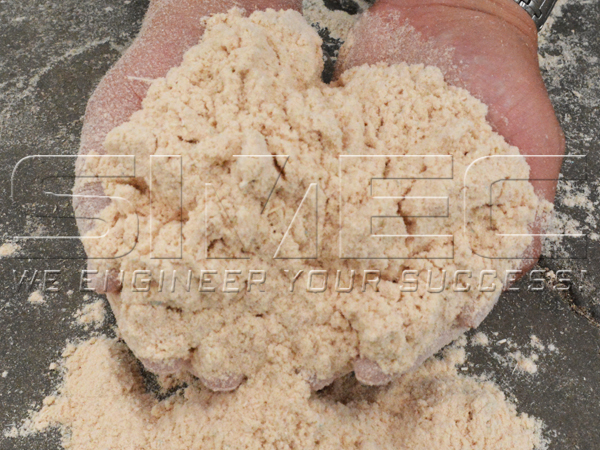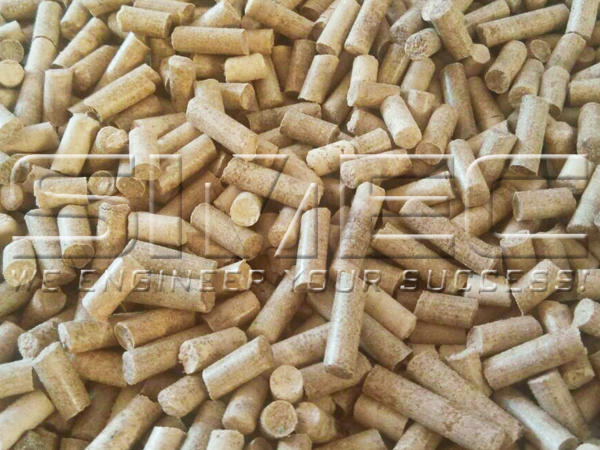Balsa Wood Pelletizing Test Video
On 15th June, 2016, we arranged pelletizing test by SPM520 pelletizer.
The raw material for pelletizing test is Balsa wood dust originally from Papua New Guinea , density 150 Kg/M3.
The balsa wood dust is collected from dust extraction system of woodworking workshop.
Diameter of the balsa wood pellets is 8mm.

Balsa Wood Dust

Balsa Wood Pellet
Demo video for balsa wood pelletizing test:
Some knowledge about Balsa Wood:
Common Name(s): Balsa
Scientific Name: Ochroma pyramidale
Distribution: Tropical regions of the Americas; also grown on plantations
Tree Size: 60-90 ft (18-28 m) tall, 3-4 ft (1-1.2 m) trunk diameter
Average Dried Weight: 9 lbs/ft3 (150 kg/m3)
Specific Gravity (Basic, 12% MC): .12, .15
Janka Hardness: 90 lbf (390 N)
Modulus of Rupture: 2,840 lbf/in2 (19.6 MPa)
Elastic Modulus: 538,000 lbf/in2 (3.71 GPa)
Crushing Strength: 1,690 lbf/in2 (11.6 MPa)
Shrinkage: Radial: 2.3%, Tangential: 6.0%, Volumetric: 8.5%, T/R Ratio: 2.6
Color/Appearance: Heartwood tends to be a pale reddish brown color, though it is not commonly seen in commercial lumber. Most boards/blocks of Balsa are from the sapwood, which is a white to off-white or tan color, sometimes with a pink or yellow hue.
Grain/Texture: Balsa has a straight grain with a medium to coarse texture and low natural luster.
Endgrain: Diffuse-porous; large pores in no specific arrangement; solitary and radial multiples of 2-3; growth rings indistinct; rays visible without lens; parenchyma typically not visible with lens.
Rot Resistance: Sapwood is rated as perishable, and is also susceptible to insect attack.
Workability: Generally very easy to work with virtually no dulling effect on cutters; yet because of its extremely low density, fuzzy surfaces can be a problem when using dull cutters. Balsa generally should not be used to hold nails, with glue being the preferred method of joining. Balsa stains and finishes well, though it has a tendency to soak up large quantities of material on the initial coats.
Odor: No characteristic odor.
Allergies/Toxicity: Although severe reactions are quite uncommon, Balsa has been reported to cause skin irritation. See the articles Wood Allergies and Toxicity and Wood Dust Safety for more information.
Pricing/Availability: High quality Balsa (that is, Balsa with a very low density) can be rather expensive when purchased at hobby stores or other specialty outlets. Larger boards and lumber sold through typical hardwood dealers is hard to find, but generally has a better cost per board-foot than other sources.
Sustainability: This wood species is not listed in the CITES Appendices or on the IUCN Red List of Threatened Species.
Common Uses: Buoys, rafts, surfboards, model airplanes, musical instruments, packing/transport cases, core stock in sandwich laminations, and fishing lures.
Comments: Balsa is a wood that is famous worldwide. And while its density and mechanical values can vary significantly depending on the growing conditions of any particular tree, it is generally the lightest and softest of all commercial woods, ranging from 8 to 14 pounds per cubic foot. Yet despite its softness, Balsa is technically classified as a hardwood, rather than a softwood, since it has broad leaves and is not a conifer.
Balsa has excellent sound, heat, and vibration insulating properties, and is also incredibly buoyant: in fact, “Balsa” is the Spanish word for “raft.”
The raw material for pelletizing test is Balsa wood dust originally from Papua New Guinea , density 150 Kg/M3.
The balsa wood dust is collected from dust extraction system of woodworking workshop.
Diameter of the balsa wood pellets is 8mm.

Balsa Wood Dust

Balsa Wood Pellet
Demo video for balsa wood pelletizing test:
Some knowledge about Balsa Wood:
Common Name(s): Balsa
Scientific Name: Ochroma pyramidale
Distribution: Tropical regions of the Americas; also grown on plantations
Tree Size: 60-90 ft (18-28 m) tall, 3-4 ft (1-1.2 m) trunk diameter
Average Dried Weight: 9 lbs/ft3 (150 kg/m3)
Specific Gravity (Basic, 12% MC): .12, .15
Janka Hardness: 90 lbf (390 N)
Modulus of Rupture: 2,840 lbf/in2 (19.6 MPa)
Elastic Modulus: 538,000 lbf/in2 (3.71 GPa)
Crushing Strength: 1,690 lbf/in2 (11.6 MPa)
Shrinkage: Radial: 2.3%, Tangential: 6.0%, Volumetric: 8.5%, T/R Ratio: 2.6
Color/Appearance: Heartwood tends to be a pale reddish brown color, though it is not commonly seen in commercial lumber. Most boards/blocks of Balsa are from the sapwood, which is a white to off-white or tan color, sometimes with a pink or yellow hue.
Grain/Texture: Balsa has a straight grain with a medium to coarse texture and low natural luster.
Endgrain: Diffuse-porous; large pores in no specific arrangement; solitary and radial multiples of 2-3; growth rings indistinct; rays visible without lens; parenchyma typically not visible with lens.
Rot Resistance: Sapwood is rated as perishable, and is also susceptible to insect attack.
Workability: Generally very easy to work with virtually no dulling effect on cutters; yet because of its extremely low density, fuzzy surfaces can be a problem when using dull cutters. Balsa generally should not be used to hold nails, with glue being the preferred method of joining. Balsa stains and finishes well, though it has a tendency to soak up large quantities of material on the initial coats.
Odor: No characteristic odor.
Allergies/Toxicity: Although severe reactions are quite uncommon, Balsa has been reported to cause skin irritation. See the articles Wood Allergies and Toxicity and Wood Dust Safety for more information.
Pricing/Availability: High quality Balsa (that is, Balsa with a very low density) can be rather expensive when purchased at hobby stores or other specialty outlets. Larger boards and lumber sold through typical hardwood dealers is hard to find, but generally has a better cost per board-foot than other sources.
Sustainability: This wood species is not listed in the CITES Appendices or on the IUCN Red List of Threatened Species.
Common Uses: Buoys, rafts, surfboards, model airplanes, musical instruments, packing/transport cases, core stock in sandwich laminations, and fishing lures.
Comments: Balsa is a wood that is famous worldwide. And while its density and mechanical values can vary significantly depending on the growing conditions of any particular tree, it is generally the lightest and softest of all commercial woods, ranging from 8 to 14 pounds per cubic foot. Yet despite its softness, Balsa is technically classified as a hardwood, rather than a softwood, since it has broad leaves and is not a conifer.
Balsa has excellent sound, heat, and vibration insulating properties, and is also incredibly buoyant: in fact, “Balsa” is the Spanish word for “raft.”